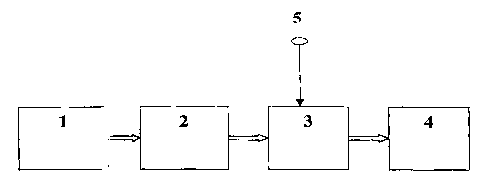Une partie des informations de ce site Web a été fournie par des sources externes. Le gouvernement du Canada n'assume aucune responsabilité concernant la précision, l'actualité ou la fiabilité des informations fournies par les sources externes. Les utilisateurs qui désirent employer cette information devraient consulter directement la source des informations. Le contenu fourni par les sources externes n'est pas assujetti aux exigences sur les langues officielles, la protection des renseignements personnels et l'accessibilité.
L'apparition de différences dans le texte et l'image des Revendications et de l'Abrégé dépend du moment auquel le document est publié. Les textes des Revendications et de l'Abrégé sont affichés :
| (12) Demande de brevet: | (11) CA 2378524 |
|---|---|
| (54) Titre français: | DISPOSITIF DE COAGULATION DE TISSUS |
| (54) Titre anglais: | DEVICE FOR COAGULATION OF TISSUES |
| Statut: | Réputée abandonnée et au-delà du délai pour le rétablissement - en attente de la réponse à l’avis de communication rejetée |
| (51) Classification internationale des brevets (CIB): |
|
|---|---|
| (72) Inventeurs : |
|
| (73) Titulaires : |
|
| (71) Demandeurs : |
|
| (74) Agent: | SMART & BIGGAR LP |
| (74) Co-agent: | |
| (45) Délivré: | |
| (86) Date de dépôt PCT: | 1999-08-06 |
| (87) Mise à la disponibilité du public: | 2001-02-15 |
| Licence disponible: | S.O. |
| Cédé au domaine public: | S.O. |
| (25) Langue des documents déposés: | Anglais |
| Traité de coopération en matière de brevets (PCT): | Oui |
|---|---|
| (86) Numéro de la demande PCT: | PCT/RU1999/000276 |
| (87) Numéro de publication internationale PCT: | RU1999000276 |
| (85) Entrée nationale: | 2002-02-05 |
| (30) Données de priorité de la demande: | S.O. |
|---|
L'invention concerne un dispositif destiné à la coagulation électrique de tissus, qui comprend une source d'alimentation haute tension, un régulateur de l'intensité de traitement et une sonde; le dispositif est muni d'un transformateur de tension piézo-électrique qui permet de réguler automatiquement l'intensité de traitement lors du processus de coagulation et de couper automatiquement le dispositif une fois ledit processus de coagulation terminé, ce qui permet de réduire la profondeur de la nécrose de tissus.
The invention relates to a device for electric coagulation of tissues, which
contains a high voltage power supply, a treatment power regulator and a probe;
the device is provided with a piezoelectric voltage transformer which allows
for automatic control of treatment power during coagulation and for automatic
turnoff of the device once the coagulation process is over, thereby making it
possible to reduce the depth of tissue necrosis.
Note : Les revendications sont présentées dans la langue officielle dans laquelle elles ont été soumises.
Note : Les descriptions sont présentées dans la langue officielle dans laquelle elles ont été soumises.

2024-08-01 : Dans le cadre de la transition vers les Brevets de nouvelle génération (BNG), la base de données sur les brevets canadiens (BDBC) contient désormais un Historique d'événement plus détaillé, qui reproduit le Journal des événements de notre nouvelle solution interne.
Veuillez noter que les événements débutant par « Inactive : » se réfèrent à des événements qui ne sont plus utilisés dans notre nouvelle solution interne.
Pour une meilleure compréhension de l'état de la demande ou brevet qui figure sur cette page, la rubrique Mise en garde , et les descriptions de Brevet , Historique d'événement , Taxes périodiques et Historique des paiements devraient être consultées.
| Description | Date |
|---|---|
| Inactive : CIB de MCD | 2006-03-12 |
| Demande non rétablie avant l'échéance | 2004-08-06 |
| Le délai pour l'annulation est expiré | 2004-08-06 |
| Réputée abandonnée - omission de répondre à un avis sur les taxes pour le maintien en état | 2003-08-06 |
| Lettre envoyée | 2002-12-04 |
| Lettre envoyée | 2002-12-04 |
| Inactive : Transfert individuel | 2002-10-24 |
| Inactive : Page couverture publiée | 2002-08-02 |
| Inactive : Lettre de courtoisie - Preuve | 2002-07-30 |
| Inactive : Notice - Entrée phase nat. - Pas de RE | 2002-07-26 |
| Demande reçue - PCT | 2002-04-29 |
| Exigences pour l'entrée dans la phase nationale - jugée conforme | 2002-02-05 |
| Demande publiée (accessible au public) | 2001-02-15 |
| Date d'abandonnement | Raison | Date de rétablissement |
|---|---|---|
| 2003-08-06 |
Le dernier paiement a été reçu le 2002-06-25
Avis : Si le paiement en totalité n'a pas été reçu au plus tard à la date indiquée, une taxe supplémentaire peut être imposée, soit une des taxes suivantes :
Les taxes sur les brevets sont ajustées au 1er janvier de chaque année. Les montants ci-dessus sont les montants actuels s'ils sont reçus au plus tard le 31 décembre de l'année en cours.
Veuillez vous référer à la page web des
taxes sur les brevets
de l'OPIC pour voir tous les montants actuels des taxes.
| Type de taxes | Anniversaire | Échéance | Date payée |
|---|---|---|---|
| TM (demande, 2e anniv.) - générale | 02 | 2001-08-06 | 2002-02-05 |
| Taxe nationale de base - générale | 2002-02-05 | ||
| TM (demande, 3e anniv.) - générale | 03 | 2002-08-06 | 2002-06-25 |
| Enregistrement d'un document | 2002-10-24 |
Les titulaires actuels et antérieures au dossier sont affichés en ordre alphabétique.
| Titulaires actuels au dossier |
|---|
| INTELLIKRAFT LIMITED |
| Titulaires antérieures au dossier |
|---|
| DMITRY VLADIMIROVICH FROLOV |
| ELENA IGOREVNA KRUTOVA |
| JURY LEONIDOVICH SPIRIN |
| VLADIMIR STEPANOVICH DUBININ |